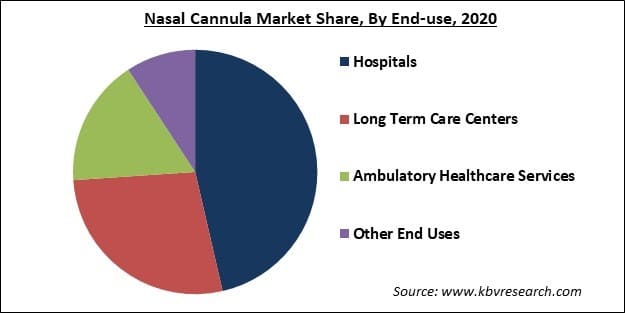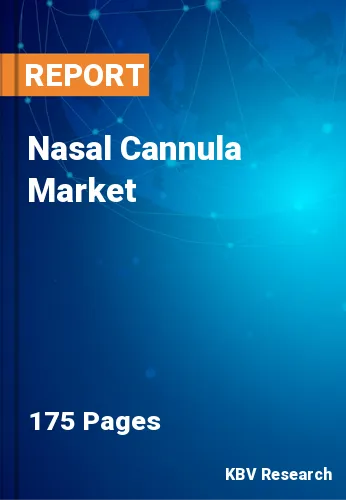The Global Nasal Cannula Market size is expected to reach $7.9 billion by 2027, rising at a market growth of 4% CAGR during the forecast period. The nasal cannula refers to medical equipment which is used to provide oxygen to people when they are unable to get a sufficient amount of oxygen for optimum body functioning. This condition arises due to chronic obstructive pulmonary disease (COPD), other respiratory disorders, and allergic reactions, or environmental change. Nasal cannulas are connected to the oxygen sources. They are easy to use, lightweight, and affordable. Nasal cannula finds potential applications in hospital settings, clinics, at home, or on the go.
Moreover, a nasal cannula is considered as a medical device that is a small and flexible tube. It consists of two open prongs that are intended to put just inside the nostrils. These tubes are connected to an oxygen source and supply a steady stream of medical-grade oxygen in the nose to facilitate the breathing process among patients. The low oxygen concentration is used to deliver oxygen with the help of nasal cannulas.
For higher concentration oxygen supply, high-flow cannulas are also available in the market. These nasal cannulas allow output somehow similar to continuous positive airway pressure systems (CPAP). Nasal cannulas are less invasive if compared to other oxygen delivery systems. In contrast to facemask, the nasal cannulas don’t interrupt regular eating and talking. These small nasal cannulas are portable in nature.

The increasing occurrence of respiratory diseases, growing geriatric population, and rising adoption are the factors accrediting to the market growth of nasal cannula across the globe. Furthermore, the ongoing Covid 19 pandemic has also increased the demand for nasal cannulas in many countries. Thus, the key players are focused to increase the production of the nasal cannula in order to meet the demand swiftly.
The major market players are aiming at research & development activities and technological advancement to bring more flexible and comfortable nasal cannula in the market. It facilitates more application of nasal cannula in the treatment of several indications. The extensive distribution network and the increasing e-commerce facility have empowered the availability of the products across the globe resulted in the increasing adoption of these products and thus, driving the market growth of the nasal cannula.
The sudden outbreak of the COVID-19 has a severe impact on the healthcare system all across the globe. This disease was first detected in Wuhan City in 2019, and declared a global pandemic by the WHO as a pandemic that has affected almost all the countries around the world. Predominantly, the community patient population is at greater risk of infection. At the same time, they are facing the potential failure of proper medication due to the pandemic. It is a human-to-human transmission. According to the WHO, more than 3300 clinicians have been infected in China and around 1116 clinicians infected in Italy by 13 March 2020.
By the end of Room surfaces in the vicinity of coronavirus disease 2019 (COVID-19) symptomatic patients and 2020, millions and millions of people including healthcare workers are affected by this disease across the world. In certain regions, it has been recognized as a deadly disease mainly due to the lack of proper healthcare facilities. As COVID-19 is a respiratory disease, it mainly affects the lungs. The primary strategy for treating COVID-19 patients is to provide supportive care like oxygen therapy. Hypoxemic patients need a high-flow nasal cannula (HFNC) to improve oxygenation. Hence, the COVID-19 pandemic has a positive impact on the demand for nasal cannula. The market is facing a very high demand and thus, created various lucrative opportunities for the market players during the pandemic.
Based on Material, the market is segmented into Plastic and Silicone. The plastic nasal cannula was the leading segment of the market. It procured the largest revenue share in 2020. The factors contributing to the growth of this segment include low cost and easier availability of the product in the market. The plastic nasal cannula provides more comfort and flexibility to the patients, comprising the long-term users. Moreover, the silicone-made nasal cannula is also gaining popularity.

Based on End Use, the market is segmented into Hospitals, Long Term Care Centers, Ambulatory Healthcare Services, and Other End Uses. The long-term care center segment would exhibit a major growth rate during the forecast period. It is due to growth in the geriatric population. In addition, the rising number of patients who are suffering from long-term respiratory distress is also estimated to boost the demand for long-term care centers.
Based on Type, the market is segmented into Low Flow Nasal Cannula and High Flow Nasal Cannula. The high-flow nasal cannula segment is also witnessing increasing demand. This is due to the rising adoption of the high-flow nasal cannula in the treatment of severely ill patients as it provides respiratory support to them. The recent advancements and developments in the manufacturing of the high flow cannula further expand its usage in low-level healthcare settings or home use.
| Report Attribute | Details |
|---|---|
| Market size value in 2020 | USD 6.5 Billion |
| Market size forecast in 2027 | USD 7.9 Billion |
| Base Year | 2020 |
| Historical Period | 2017 to 2019 |
| Forecast Period | 2021 to 2027 |
| Revenue Growth Rate | CAGR of 4% from 2021 to 2027 |
| Number of Pages | 175 |
| Number of Tables | 340 |
| Report coverage | Market Trends, Revenue Estimation and Forecast, Segmentation Analysis, Regional and Country Breakdown, Companies Strategic Developments, Company Profiling |
| Segments covered | Material, End Use, Type, Region |
| Country scope | US, Canada, Mexico, Germany, UK, France, Russia, Spain, Italy, China, Japan, India, South Korea, Singapore, Malaysia, Brazil, Argentina, UAE, Saudi Arabia, South Africa, Nigeria |
| Growth Drivers |
|
| Restraints |
|
Based on Regions, the market is segmented into North America, Europe, Asia Pacific, and Latin America, Middle East & Africa. The Asia Pacific would be the fastest growing region of the nasal cannula market over the forecast period. It is attributed to the high prevalence of asthma and COPD among the population of this region. The growing geriatric population in the countries of the Asia pacific is also leading to increased demand for nasal cannula in this region. The increasing healthcare expenditure and the upsurge in the number of local manufacturers further boost the growth of the market in the region.
Free Valuable Insights: Global Nasal Cannula Market size to reach USD 7.9 Billion by 2027
The market research report covers the analysis of key stake holders of the market. Key companies profiled in the report include Allied Healthcare Products, Inc., Besmed Health Business Corporation, ResMed, Inc., Teleflex, Inc., Medical Depot, Inc. (Drive DeVilbiss Healthcare), Fairmont Medical Products Pty. Ltd., Fisher and Paykel Healthcare Limited, Sunset Healthcare Solutions, Inc., Smiths Group PLC, and Flexicare Medical Ltd.
By Material
By End Use
By Type
By Geography
The global nasal cannula market market size is expected to reach $7.9 billion by 2027.
Flexibility for patients is continuously increasing about the use of the nasal cannula are driving the market in coming years, however, Irritation and nasal dryness caused by the nasal cannula in some patients limited the growth of the market.
Allied Healthcare Products, Inc., Besmed Health Business Corporation, ResMed, Inc., Teleflex, Inc., Medical Depot, Inc. (Drive DeVilbiss Healthcare), Fairmont Medical Products Pty. Ltd., Fisher and Paykel Healthcare Limited, Sunset Healthcare Solutions, Inc., Smiths Group PLC, and Flexicare Medical Ltd.
The COVID-19 pandemic has a positive impact on the demand for nasal cannula. The market is facing a very high demand and thus, created various lucrative opportunities for the market players during the pandemic.
The low flow segment of the nasal cannula market procured the largest revenue share in 2020.
The hospital segment emerged as the dominating segment in the nasal cannula market. This segment accounted for the largest revenue share in 2020.
Our team of dedicated experts can provide you with attractive expansion opportunities for your business.

